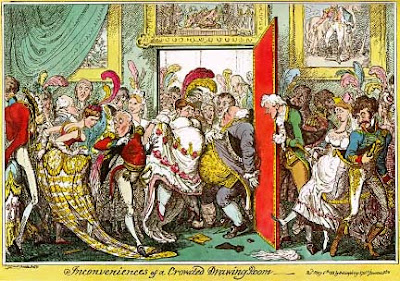Hand-Drawn Lettering and Experimental Typography
This beautifully hand drawn alphabet is by Blake E. Marquis.
Graphic designers take note, there is an interesting traveling exhibition, titled Alphabet: An Exhibition of Hand-Drawn Lettering and Experimental Typography, which can be viewed now in Orlando, coinciding with the AIGA Conference.
“Focusing on an ordinary subject that we see each day, often in the hundreds of thousands, Alphabet presents 26 letters as more than just shapes for conveying information. The 48 artists and designers in this show conceive and interpret the alphabet in surprising and inventive ways, ranging from graceful and polished to witty and unconventional. The 60 alphabets featured in Alphabet were created by artists in North America, Europe, and Asia, and represent work from well-known typographers and designers as well as rising artists and design students.” – excerpt from the exhibition website.
ALPHABET GALLERY
Below are selected samples of some of the alphabets shown in the exhibition. Complete character sets (A-Z) of each alphabet in the show can be seen in the exhibition catalog or at one of the exhibition venues.
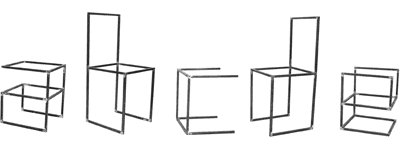 ANDREW BYROM / INTERIORS / 2003
ANDREW BYROM / INTERIORS / 2003
A set of 26 table and chair frames built from steel tubing, Interiors forms a lowercase alphabet when viewed from certain angles. While some of the letters such as the h, m, and b look like basic chairs or tables, others like the e, t, and x become abstract, rather than functional, furniture.
Fabrication: Joel Wolter
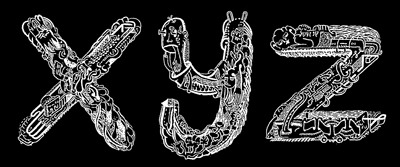 LUKE RAMSEY AND A. PURDY / HYPER TYPE / 2005
LUKE RAMSEY AND A. PURDY / HYPER TYPE / 2005
Representing the pair's first collaboration, Hyper Type's obsessively detailed letterforms were created by Ramsey and Purdy in two marathon, ten-hour days.
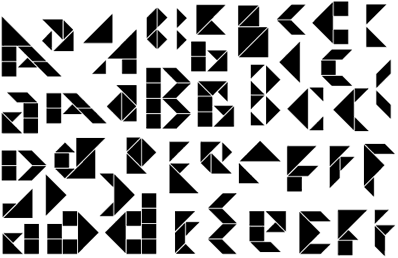 APIRAT INFAHSAENG / SEVEN BOARD OF CUNNING / 2004
APIRAT INFAHSAENG / SEVEN BOARD OF CUNNING / 2004
Constructed with Chinese Tangram puzzle tiles, Seven Board of Cunning takes the concept of Tangrams--that the tiles may be arranged into a variety of shapes--and applies it to typography, creating multiple versions of each letter.
 MICHAEL STOUT (VISUALINGUAL) / IMAGEABILITY, PATHS / 2002
MICHAEL STOUT (VISUALINGUAL) / IMAGEABILITY, PATHS / 2002
Pushing the limits of legibility, Imageability is a series of five fonts based on ideas from the book of the same title by Kevin Lynch. By reducing each letter to a minimal set of forms, Imageability explores the identifiers we use to navigate our landscape and language.
Exhibition info:
Website
Travel information
Alphabet will be traveling through 2008. Upcoming and past shows include:
October-November 2008 / Southern Illinois University / Edwardsville, IL
December 2007 / Ohio Northern University / Ada, OH
October 2007 / Cooper Union / New York, NY
July 2007 / AIGA Orlando / Orlando, FL
February-March 2007 / Minneapolis College of Art & Design / Minneapolis, MN
January 2007 / Pennsylvania College of Art & Design / Lancaster, PA
November 2006 / Northern Illinois University / DeKalb, IL
March 2006 / Workhorse Gallery / Los Angeles, CA
January-February 2006 / M-80 / Milwaukee, WI
November 2005 / Heaven Gallery / Chicago, IL
August 2005 / Lump Gallery / Raleigh, NC
July 2005 / Maryland Institute College of Art / Baltimore, MD
Select list of artists, designers and students, who are featured in the exhibit:
Andrew Byrom
Danielle Foushee
Arjen Noordeman
Paul Nudd
C.W. Roelle
Visualingual
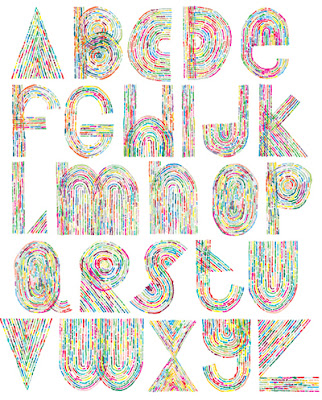
 Amy Leidtke
Amy Leidtke